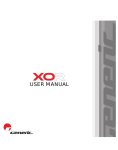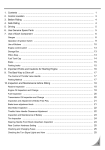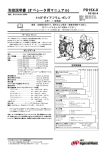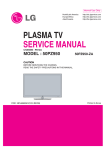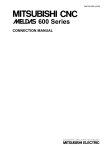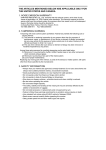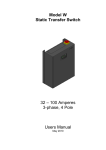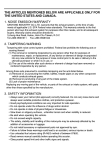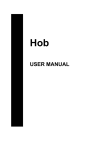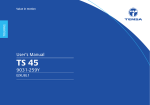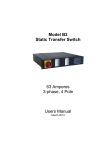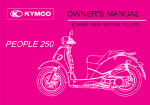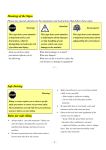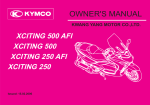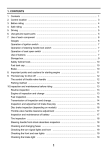Download "user manual"
Transcript
1. 2. 3. 4. 5. 6. 7. CONTENTS ................................................................................................................ CONTROL LOCATION ............................................................................................. BEFORE RIDING ....................................................................................................... USE GENUINE SPARE PARTS .............................................................................. SAFE RIDING ............................................................................................................. RIDING ........................................................................................................................ USE OF EACH COMPONENT ................................................................................ 1 3 5 5 6 7 8 Gauges ......................................................................................................................... 8 Operation of Ignition switch ......................................................................................... 11 Steering handle lock ................................................................................................... 11 Use of buttons ............................................................................................................. 12 Fuel tank cap .............................................................................................................. 14 Brake ............................................................................................................................ 14 8. IMPORTANT POINTS AND CAUTIONS FOR STARTING ENGINE ............... 15 Method of starting the engine ....................................................................................... 15 9. RIDING THE MOTORCYCLE ................................................................................ 16 Set up riding ................................................................................................................ 16 Riding in grade ............................................................................................................ 17 Transmission operation ............................................................................................... 17 Correct riding .............................................................................................................. 17 The control of throttle valve handle ............................................................................. 18 Parking method ........................................................................................................... 19 10.INSPECTION AND MAINTENANCE BEFORE RIDING .................................... 20 Routine inspection ...................................................................................................... 20 Fuel inspection ............................................................................................................ 20 Fuel coke cleaning ...................................................................................................... 21 Engine oil inspection and change ............................................................................... 21 Oil filter cleaning ......................................................................................................... 22 Inspection and adjustment of brake free play ............................................................. 23 Brake lever adjustment knob ...................................................................................... 23 Clutch lever ................................................................................................................. 24 Throttle valve handle clearance adjustment ................................................................ 25 1. Contents 1 Wiring rubber cap ......................................................................................................... 25 Drive chain .................................................................................................................. 25 Tire inspection ............................................................................................................. 26 Steering handle front shock absorbers inspection ...................................................... 27 Checking the lubrication of body’s various mechanisms ............................................ 27 Back mirror .................................................................................................................. 27 License plate ............................................................................................................... 27 Inspection and maintenance of battery ....................................................................... 28 Checking and changing fuses ..................................................................................... 29 Checking the turn signal lights and horn ..................................................................... 29 Checking the front and rear lights ............................................................................... 30 Checking the brake light ............................................................................................. 30 Checking the spark plug ............................................................................................. 30 Checking the air cleaner ............................................................................................. 31 11. WHEN THERE IS AN ABNORMAL CONDITION OR A TROUBLE ................. 32 Diagnosis when engine does not start ........................................................................ 32 12. SUGGESTIONS ON ENGINE FUEL ..................................................................... 13. CAUTIONS FOR RIDING MOTORCYCLE .......................................................... 14. PERIODICAL MAINTENANCE SCHEDULE ......................................................... 15. SPECIFICATION ...................................................................................................... 1. Contents 2 32 33 34 35 MODEL: WOLF SERIES Oil inspection window ENG. Stop / Starter switch Front turn signal light High & Low beam /Turn signal / Horn switch Rear turn signal light Ignition switch Fuel tank cap Fuses & Battery Tail light Headlight Main stand Side stand Air cleaner Front brake lever Clutch lever Rear brake pedal Muffler Shift pedal 2. Control location 3 Oil inspection window ENG. Stop / Starter switch Front turn signal light High & Low beam /Turn signal / Horn switch Rear turn signal light Ignition switch Fuel tank cap Fuses & Battery Tail light Headlight Side stand Air cleaner Front brake lever Clutch lever Rear brake pedal Muffler Shift pedal 4 2. Control location This manual describes the correct usage of this motorcycle including safety riding, simple inspection methods and so on. For a more comfortable and safety riding, please read this manual carefully. For your benefit, please ask your SANYANG dealer the operating manual and carefully read the following: Correct use of the motorcycle. Pre-delivery inspection and maintenance. Thank you very much for your patronage In order to maximize your motorcycle’s performance, a periodical inspection and maintenance should be completely carried out. We recommend that after riding your new motorcycle for the first 300 kilometers, you should take your motorcycle to the original dealer for an initial inspection, and to have your motorcycle inspected periodically every 1000 kilometers thereafter. In case the motorcycle’s specifications and construction are modified and different from the photos and diagrams on the owner’s manual / catalogues, the specifications and construction of the actual motorcycle shall prevail. 4. USE GENUINE SPARE PARTS In order to maintain the motorcycle’s best performance, each part’s quality, material, and machined precision must conform with the design requirements. “SYM Genuine Spare Parts” were made from the same high quality materials used for the original motorcycle. No parts would be sold to the market until they could meet the designed specifications through sophisticated engineering and stringent quality control. Therefore, it is necessary to purchase “SYM Genuine Spare Parts” from “SYM Authorized Dealers or Franchised Dealers” when replacing spare parts. If you buy cheap, or fake substitute parts from the market, no guarantee can be provided either for the quality or durability. Also, it may result in unexpected troubles and lower the motorcycle’s performance. Always use SYM Genuine Spare Parts to keep your motorcycles pure blood and to ensure its long service life. 3. Before riding 4. Use genuine spare parts 5 It is very important to be relax and clothe properly when riding, observe traffic regulations, do not rush, always drive carefully and relaxed. Obey all national and local laws and regulations. Usually, most people would ride their newly bought motorcycle very carefully, but after they became familiar with their motorcycles, they tended to become reckless which may result in an accident. To remind you: Please wear a safety helmet, and properly tighten the chin belt when riding a motorcycle. Clothes with open or loose cuffs may be blown by wind and cause the cuffs to get caught on the steering handle and thus affects riding safety. So, put on clothes with tight sleeves. Hold the steering handle by both hands when riding. Never ride with only one hand. Observe the speed limit. Wear suitable low-heel shoes. Perform periodical maintenance and inspection in accordance with the schedule. WARNING!! To avoid getting burned by exhaust pipe when taking a passenger. Make sure your passenger has put his/her feet on the pedals. After running, the exhaust pipe is very hot, be careful not to get burned when conducting an inspection or maintenance. After running, the exhaust pipe is very hot, select a suitable location to park your motorcycle to avoid others getting burned by the exhaust pipe. CAUTION: Modified motorcycle will affect its structure or performance, and cause poor engine operation or exhaust noise, which will result in shortening the motorcycle’s service life. Besides, modification is illegal and does not conform to the original design and specifications. A modified motorcycle will not be covered by warranty, therefore, do not modify your motorcycle at will. 6 5. Safe riding Keep the related parts of your body such as arms, palms, lumbar, and toes relax and ride with the most comfortable posture in order to be able to react quickly whenever it is necessary. Rider’s posture will greatly affect riding safety. Always keep your body’s gravity in the center of the seat, if your body’s gravity is on the rear part of seat, the front wheel load will be reduced, and this will cause the steering handle shaking. It is dangerous to ride a motorcycle with an unstable handle. It will be much easier to make a turn if rider inclines his body inward when turning. On the other hand, the rider will feel unstable if his body and the motorcycle do not incline. The motorcycle is hard to control on a bumpy, unleveled, unpaved road, try to know the road conditions in advance, slow down and use your shoulder’s force to control the handle. Suggestion: Do not load objects on the handle, to avoid affecting the riding safety and the operation of steering handle. CAUTION: The rider’s feeling on the handle is slightly different with a load or without a load. Overload may cause the handle to swing and affects the riding safety. Therefore, do not overload your motorcycle. CAUTION: Do not place flammable materials such as rags between the body side cover and engine to avoid components damaging by fire. Do not load objects on areas not specified for loading to avoid damage. SUGGESTION To maximize the motorcycle’s performance and prolong its service life: The first month or first 1000km is the wear- in period for the engine and components. Avoid rapid acceleration, and keep the speed below 60km/hr. 6.Riding 7 GAUGES tachometer Speedometer Turn Signal Indicator Transmission neutral Indicator “MODE” Button “SET” Button High Beam Indicator Clock Fuel gauge Odometer/ Trip odometer Oil change indicator EFi Indicator Gear Indicator tachometer Speedometer Transmission neutral Indicator Turn Signal Indicator “MODE” Button Engine Coolant Temperature Indicator High Beam Indicator “SET” Button Side Stand Down Indicator Odometer/ Fuel gauge Trip odometer EFi Indicator 8 7. Use of each component Clock/ Voltage Oil change indicator CAUTION: Do not wipe plastic components, e.g. instrument panel, headlight, with organic solvents such as gasoline…etc to avoid damaging these components. Speedometer: : This shows your speed in kilometers per hour (km/h or mile/h). On “ODO” mode, push “SET” and “MODE” button for two seconds to switch between “km” and “mile” display. (If installed) Short-press on the button 〝S〞 shows the highest speedometer record. Under the highest record mode, long-press on the button〝S〞and the highest speedometer record can be deleted. Odometer: : This odometer shows the total kilometers this motor has been driven. Trip odometer : The rider can measure the trip odometers. It shows four digits; 3 in kilometers and 1 in hundred meter. (The trip odometer will return to zero if its measurement is over 1000 kilometers or turn the reset knob.) Fuel gauge: : The fuel gauge doesn’t come on when the main switch is at “OFF” position. When key switch is turned to “ON”, and the “pointer” also in “E” position (red area). Refuel octane 92/95 unleaded gasoline immediately. High Beam Indicator: : This indicator comes on with high beam headlight is turned on. Turn Signal Indicator: : The left or right Indicator will be flashing according to the operated directions of turn signal light switch when it is turned on. Transmission neutral Indicator: : This indicator show transmission neutral. Tachometer: : Rotational speed of the engine. Engine Coolant Temperature indicator :(T2) Indicates the status of engine coolant temperature If the coolant temperature warning indicator stays ON while the engine running, Stop engine and check radiator coolant level and the fan motor. Shift position indicator:(T2) shows the current status of shift lever position. Side stand warning indicator:(T2) As long as the side stand is not up, the indicator light comes ON and the engine can be started in neutral. But the engine will be off or stop running with shifting the transmission in gear;The sidestand should be up and the indicator light is off as well, the engine could be started when the transmission is in gear. 7. Use of each component 9 Engine Oil Replacement Indicator Engine oil replacement indicator light will illuminate when the vehicle is ridden for approx. 1,000 km, which means the engine oil should be checked or replaced. Key on and press the “M” button for at least two seconds after replacing the engine oil, engine oil replacement indicator light will extinguish. Mileage Setting 1. Showing total distance and trip distance. 2. Key on and press the “M” button shortly to switch from odometer, tripmeter, clock and voltage gauge. TOTAL CLOCK TRIP CLOCK TRIP VOLTAGE 3. Press the “S” button for at least two seconds under tripmeter mode, the trip mileage can be erased. Clock Setting 1. Showing 24-hour clock system. 2. After the main switch is on, the clock will show hour and minute. 3. Under the clock mode and the vehicle is still, press the “S” button for at least two seconds to enter clock setting mode. Under the clock setting mode, press the “S” button shortly to switch setting item (hour → tens digit of minute → units digit of minute). Press the “M” button shortly to increase the digit. Under the clock setting mode, press the “S” button for at least two seconds to complete clock setting. Hour Minute (tens digit) Minute (units digit) Battery Voltage Display 1. Showing the battery voltage. 2. After the main switch is on, the battery voltage will show at least 10 seconds and then clock shows. CAUTION: If the battery voltage is below 10.0V when the main switch is on, the light system is off and the engine is not started, check the battery at SYM dealer. If the battery voltage is below 10.0V or over 16.0V when the vehicle is moving, check the battery at SYM dealer. 10 7. Use of each component OPERATION OF IGNITION SWITCH IGNITION SWITCH “Start” position Engine can be started in this position. Ignition switch key can not be removed. “Stop” position Engine is shut off and can not be started in this position . Ignition switch key can be removed. ON OFF CAUTION: Never operate the ignition switch key when the motorcycle is running. To turn the ignition switch to “OFF”, will shut off the electrical system and that may result in a dangerous accident. Therefore, the ignition switch can only be turned off after the motorcycle has been completely stopped. Always remove the key and be sure to take the key away with you after locking the steering handle before leaving your motorcycle. If ignition switch remains in the “ON” position for a prolonged period after the engine has been stopped, the battery’s capacity will be reduced and this may affect the engine’s start ability. . STEERING HANDLE LOCK The steering handle lock is located on the steering stem directly below the steering head. Turn the steering handle fully to the left Insert the ignition switch key into the lock Turn the key clockwise, then the steering handle can be locked. Remove the Ignition switch key. When unlocking, simply turn the key anti-clockwise. NOTE: For preventing the vehicle to be stolen, lock the handle bar when parked. After locked, turn of the handle bar left and right to make sure it. When leaving the vehicle, remember to remove the key. Steering handle lock 7. Use of each component 11 USE OF BUTTONS Headlight switch Turn Signal Switch Horn Switch Electrical Starter Button • Light Switches When the switch is turned to this position as the engine is being started, headlight, rear light, instrument panel light, and position light will come on. Note: Position Light Function: This light can indicate the scooter position when the scooter is running in dim, rainy, or foggy weather. When the switch is turned to this position as the engine is being started, rear light, instrument panel light, and position light will come on. When the switch is turned to this position, all lights will go off. • Electrical Starter Button This is a starting motor button (switch) for engine starting. With the main switch "ON", press this button while holding the front or rear brake lever will start the engine. CAUTION: Release this button immediately after engine has been started, and never press the button again to avoid damaging the engine. This mechanism is a safety design. The engine can only be started after the front or rear brake lever (pedal) has been applied. Do not use light system. Turn headlight and turn signal lights to the “OFF” position when the engine is being started. • Horn Switch Press this button down when ignition switch is in the “ON” position, the horn will sound. CAUTION: Do not press this button when you are in the area where there’s no honking. 7. Use of each component 12 • Turn Signal Switch Turn signal lights are used when turning left/right or changing lane. Turn ignition switch to “ON”, and slide the turn signal switch to left or right. Then, the turn signal lights will flash. To release, simply return the turn signal light button to the original position. Right-side turn signal light flashing means you intend to make a right turn. Left-side turn signal light flashing means you intend to make a left turn. Engine Stop Switch PASS High / Low Beam Switch • Engine Stop Switch Switch to this position to turn off the engine when a state of emergency. Switch to this position and the engine can be started. • High/Low Beam Switch This is the high and low beam of headlight switching switch. Press this switch to switch between high and low beams. This is for high beam. This is for low beam. (Please turn to low beam when riding in city) • Passing Switch Turn ignition switch “ON” and press this button down. Then, the high beam of headlight will come on immediately to warn the driver of the vehicle ahead that you intend to overtake him/her. (For overtaking, high beam indicator will come on at this time) This button will return to original position after releasing. 7. Use of each component 13 FUEL TANK CAP OPEN: Turn the fuel tank cap to the left, then the cap can be removed. CLOSE: Align the pin on the cap with fillister on the tank, and turn the cap right to lock the fuel cap. CAUTION: Main stand should be put down on the ground, engine should be shut off and flames should be strictly prohibited to ensure safety when refueling. Do not fill above fuel upper limit when refueling. Otherwise, fuel will flow out through a hole on the cap that may damage the body’s painting, in serious cases, it may cause a fire to burn down the motorcycle. Make sure the cap has been tighten properly. BRAKE Avoid unnecessary sudden braking. Use front and rear wheel brakes simultaneously when braking. Avoid brake continuously for a long period of time because that may overheat the brakes and reduce its braking efficiency. Slow down and brake early when riding in rainy days on slippery roads. Never apply the brakes suddenly to prevent skidding and falling. Using only the front brake or the rear brake increases the risk of falling because the motorcycle is tend to pulled to one side. 《Engine Brake》 》 Return the throttle valve handle back to its original position, and apply engine brake. It is necessary to apply both brake and engine brake intermittently when riding on a long or stiff slope. For Front Wheel 7. Use of each component 14 METHOD OF STARTING THE ENGINE (Start the engine with start motor) CAUTION: Please check the oil and fuel volume before starting the engine. Start the engine in a ventilative area. 1. Turn the ignition switch “ON position” with ignition key.. 2. Is there enough fuel in the fuel tank? 3. Shift the transmission into neutral. The neutral 4. Don’t turn the throttle grip, press the starter indicator (green) lights. button. [We care for you! Before drive off, keep the foot brake applied on the rear wheel.] CAUTION: Release the starter button immediately after starting the engine. Don’t press the starter button when the engine is running. If the engine fails to start after 3~4 attempts with the starter button, open the throttle. CAUTION: If engine can not be started after starter motor running for 3~5 seconds, turn the throttle valve handle 1/8~1/4 turns, and then press starter button again for an ease start. In order to avoid damaging the starter motor, please do not press the starter button continuously over 15 seconds. If engine still can not be started after pressing starter button over 15 seconds, stop and wait for 10 seconds before start it again. It is harder to get the engine started after the motorcycle has been left idle for a long time or after refueling only after the fuel has been depleted. Then, it is necessary to press starting lever or starter button several times, and keep the throttle valve handle at the close position to start the engine. It may need several minutes to warm up engine if it is a cold start. Exhaust contains harmful gases (CO), therefore please start the engine at a well ventilated place. 8. Important points and cautions for starting engine 15 SET UP RIDING Check the brakes and tire pressure before riding. 1. Squeeze the clutch lever fully, then push shift pedal down to engage the 1st gear. 2. Then release the clutch lever slowly, and at the same time, open the throttle gradually, the motorcycle will move. CAUTION: After the engine was started and before riding, don’t operate the throttle to rise up the engine speed. Change the gear position according to the driving speed. The relationship between speed and gear position is on the right table. Change the gear position according with the table can get the good performance and fuel economy of the motorcycle. CAUTION: During the first 1,000km, it is better to drive in low speed for running the engine in good condition and long life. Change the engine oil and clean the oil filter element after first 300km. It is better to drive in low speed after replacing the engine. Warm up the engine before start riding. 16 9.Riding the motorcycle RIDING IN GRADE Up Grade Riding up a slightly grade can ride with high position gear. Under heavy loading or steep grade riding condition, It must ride with low gear. Down Grade Close the throttle and operate the brakes when riding down a slight grade. Shift the gear to low gear in case of heavy loading or riding down steep grade condition. CAUTION: Braking apply both the front and rear brakes. TRANSMISSION OPERATION The change pedal is located on the left side of the engine. Shift transmission to the lower gear when driving hard or down grade. Squeeze the clutch lever fully, operate change pedal to the proper position, then release the clutch lever to make a gear change. Don’t operate the transmission when the engine is not running. Don’t operate change pedal rudely, or the transmission will be damaged. Shift the gear to the next lower position for overtaking other vehicles. 3 2 3 2 4 N 5 1 6 4 N 1 5 CORRECT RIDING Optimum Start Riding Turn on the turn signal and make sure of no vehicle coming behind before start riding. 9.Riding the motorcycle 17 THE CONTROL OF THROTTLE VALVE HANDLE Acceleration : To increase speed. When riding Deceleration on an inclined road, turn the throttle valve handle slowly to allow the engine to output its power. Acceleration Deceleration : To decrease speed. Maintenance Performance-During the initial period, it is better to ride in low speed for running the engine in good condition and long life. During the first month or first 1,000 km, never excess 80km/h. Avoid abrupt acceleration. Avoid engine running in RPM (over 8,000RPM) while under no load. Never Making Abrupt Braking Or Making A Full Turn. Make braking or making a full turn may cause wheel slip. When riding in wet or rainy conditions, making abrupt braking or making a turn may cause wheel slip, may lose control of the motorcycle. Extreme Caution When Riding In Rainy Condition. When riding in wet or rainy. Conditions needs longer distance to stopping the motorcycle. Slow the motorcycle down early to brake. When descending a grade, close the throttle fully and use both brakes to slow the motorcycle 18 9. Riding the motorcycle PARKING METHOD Brake-Apply both the front and rear brakes. Close the throttle then squeeze the brake control lever. “Brake slightly in beginning, then squeeze tightly”, it is the best way to brake. CAUTION: Use of only the front or brake may cause wheel slip. When approaching the parking lot: 1. Turn on the turn signal light early, and pay attention to the vehicles in front, from rear, left and right, then take the inner lane and approach slowly. 2. Return the throttle valve handle back to its original position, and apply brakes in advance. (Brake light comes on when braking to warn drivers of vehicles behind.) When stop completely: 3. Press the turn signal switch back to its original position, and turn the ignition switch key to “OFF” position to shut off the engine. 4. Get off the motorcycle from left side after the engine has been stopped, and select a parking place where the motorcycle will not interfere with traffic and the ground is level, then put down motorcycle’s main parking stand. 5. Hold the steering handle with your left hand, and hold down the front end of saddle or hold the parking handle on the lower-left side of saddle with your right hand. 6. Press the main parking stand with your right foot, put down the main parking stand firmly on the ground. To remind you: Lock the steering handle and remove the key after parking to prevent the motorcycle from being stolen. CAUTION: Park your motorcycle at a safe place where it will not interfere with traffic. 9. Riding the motorcycle 19 (Please refer to the components location diagram for the following components.) ROUTINE INSPECTION Check Items Check Key Points Engine Oil Is there enough engine oil? Fuel Is it enough? Is it Octane 90 or above Front Braking condition? (Brake lever free play: 10~20mm) Rear Braking condition? (Brake pedal free play: 20~30mm) Front Is tire pressure normal? (Standard: 2.0kg/cm2) Rear Is tire pressure normal? (Standard: 2.0 kg/cm2 for 1 person, 2. 25 kg/cm2 for 2 persons) Brake Tires Steering Handle Does the handle vibrate abnormally or is difficult to turn? Speedometer, lights, and rearview mirror Is it operated properly? Do lights come on? Can it be seen clearly from behind? Tightness of Main Components Are screws, nuts loosen? Abnormal Points Do the previous troubles still exist? CAUTION: If any problem founded during routine inspection, correct the problem before using the motorcycle again, have your motorcycle checked and repaired by the “SYM dealer or authorized service personnel” if necessary. FUEL INSPECTION Check fuel quantity, see if it is enough for your destination. This motorcycle’s engine is designed for using the unleaded fuel of Octane 90 or above. Firmly secure the main stand on the ground, shut off the engine and keep flames away from the motorcycle when refueling. Turn and open the fuel tank cap, then refill the gasoline. Do not fill above fuel upper limit level when refueling. Turn the fuel cock to the ”ON” position after refilling the gasoline. WARING: Stop the engine and keep away from spark and flames when refilling the fuel. Make sure that the fuel tank cap has been locked tightly after refilled. 20 10. Inspection and maintenance before riding Refill the gasoline Fuel tank cap FUEL COKE CLEANING The fuel cock is on the left-lower side of the fuel tank. There is a fuel cup on the fuel cock, and it must be cleaned period. Remove the cup oil ring and filter replace the filter if necessary. Assemble the above parts. Leakage Check fuel cup, tank, tube and carburetor for leaks. ENGINE OIL INSPECTION AND CHANGE Oil in INSPECTION: 1. Use the main parking stand to support the motorcycle on a level ground, remove the dipstick after engine stopped for 3~5 minutes. Wipe oil off the dipstick and then insert it into the guide tube again (Do not rotate it.) Upper limit 2. Remove the dipstick and check whether oil level is in between the upper and lower marks. Add oil to upper limit if oil is under the lower limit. (Check cylinder, crankcase…etc for leakage.) Lower limit OIL CHANGE: Change engine oil after the first 300km(T2 at 1,000Km), and change the engine oil every 3,000km(T2 every 5,000Km) thereafter. Change oil filter's paper element every 5,000km. In order to maintain the engine’s maximum performance, check whether the engine oil is enough every 500km. Add oil to upper limit if the engine oil has been found to be inadequate. Engine Oil : Use API SJ, SAE 10w-40, JASO MA grade or better engine oil. Otherwise, damage will not be covered by warranty. ※Recommended Oil: SYM Genuine EXTRA 4X OIL. T1→Oil Capacity : 1.2 Liter (1.0 liters for routine change). Oil filter change: 1.0 liters. Drain bolt T2→Oil Capacity : 1.7 Liter (1.5 liters for routine change). Oil filter change: 1.5 liters. 10. Inspection and maintenance before riding 21 OIL FILTER CLEANING The oil filter in engine left side, near change pedal. Open the filter nut assembly of the filter, and remove the filter. Remove the foreign materials from the filter by using a gasoline or air spraying gun. WARNING: Oil filter Oil level will not be correct when checking the oil level with the motorcycle parked on an unleveled ground or immediately after the engine stopped. Engine and exhaust pipe are hot right after engine stopped. Pay special attention not to get burned when checking or replacing engine oil. If the oil lever approach lower limit again after refilled, check the engine for leaks and refill it again. There is a powerful magnet inside and be sure to don’t lose it anyway. powerful magnet Filter nut OIL PAPER FILTER CHANGE WARING: Exchange the oil paper filter and O-ring as well. O-ring oil paper filter 22 10. Inspection and maintenance before riding INSPECTION AND ADJUSTMENT OF BRAKE FREE PLAY INSPECTION: (Brake lever and pedal free play must be checked with the engine shut off.) Brake lever and pedal free play for front and rear wheels. When checking the hand-braking lever for front wheels, its free play (the stroke of hand-braking lever from no braking to initial braking) should be 10~20mm. It is abnormal if the feel is spongy when holding the hand-braking lever forcefully. When checking the foot-braking pedal for rear wheels, its free play (the stroke of foot-braking pedal from no braking to initial braking) should be 20~30mm. It is abnormal if the feel is spongy when press the foot-braking pedal forcefully. 10~20 mm 20mm 30 mm BRAKE LEVER ADJUSTMENT KNOB (If installed) operation: Push the brake lever forward to the end (A), and turn the span adjustment knob. There are four positions on the span adjustment knob; position 1 is the shortest span between the brake lever and the handgrip with the loosest braking feel, position 4 is the longest span between the brake lever and the handgrip with the tightest braking feel. To decrease free play A To increase free play 10. Inspection and maintenance before riding 23 Adjustment: The indentation of brake adjustment nut must be aligned with the pin. (see below figure) Adjustment nut To increase free play Pin To decrease free play Adjustment nut Turn the adjustment nut on brake arm of front and rear wheels to adjust the free play of hand-brake lever. Hold the hand-brake levers after adjusting with both hands until there is effective brake feeling. Measure the free play with a rule. CAUTION: When free play is between 10~20 mm, check brake indicators of front and rear wheels. If the arrow on the brake arm aligned with the “△” marked on the brake disk, that means the brake lining has been excessively worn, and must be replaced immediately. 10~20 mm CLUTCH LEVER The clutch lever free play should be 10~20mm. Check the free play and turn the adjusting nut for adjustment if necessary. CAUTION: The function of the clutch is translating the engine power to the rear wheel, if the clutch adjustment is incorrect, it will be hard to shift or make the clutch plates slip. Make sure the shift is easy to be done after adjustment. If the clutch lever free play is too large or too small, It’s easy to damage the clutch plates. 24 10. Inspection and maintenance before riding Adjust nut Lock nut To decrease free play To increase free play THROTTLE VALVE HANDLE CLEARANCE ADJUSTMENT Correct clearance allows throttle vale handle to rotate 2~6mm. Loosen the lock nut first, then turn the adjust nut to adjust. Tighten the lock nut securely when finished. 2~6 mm Check Items: 1. Check throttle valve cable to see if it can be moved smoothly from a closed position to a wide open position. 2. Rotate steering handle from side to side to check if the throttle valve cable is interfered. 3. Check to see if the throttle valve cable is obstructed by other cables preventing it from being operated smoothly. Adjust nut Lock nut WIRING RUBBER CAP Rubber cap The rubber caps are used for protecting the wires of the wiring. Check the caps frequently for settling at right position. Do not direct water under pressure against the wiring or use brush when washing motorcycle. If the wiring is very dirty. Use cloth to scrape it. Check points DRIVE CHAIN Rubber cap The drive chain will be elongated and slackened as the using time passed. So it is necessary to be inspected and adjusted. <Drive Chain Inspection> The drive chain check lie under drive chain center, the slack of the chain should be 10~20mm. Stand the motorcycle with main stand upright. Turning the rear wheel, check the drive chain for free operation and noise. Adjust the drive chain if there is any abnormality. Scale <Drive Chain Adjustment> 1. Loose the rear wheel axle nut. Adjuster 2. Turn the adjusting nut for adjustment. Tighten the axle nut after adjusted. CAUTION: The right and left adjuster must be adjusted to same scale. Clean and lubricate the drive chain frequently. Axle nut 10. Inspection and maintenance before riding 25 TIRE INSPECTION Tires should be checked and inflated with the engine shut off. If a tire’s ground contacting curve is abnormal, check it with an air pressure gauge and inflate it to the specified pressure. Tires pressure must be checked with an air pressure gauge when cold. PLEASE REFER TO SPECIFICATIONS FOR STANDARD TIRE PRESSURE Foreign materials (nails or small stones) Crack and damage Tread wear indicator Visual check tires for frontal and lateral side walls for crack or damage. Visual check tires for any nails or small stones wedged in the tread. Check the “tread wear indicator” condition to see if tread groove depth is insufficient. A tire with a wear bar showing is worn out and should be replaced immediately. CAUTION: Abnormal tire pressure, wear, or crack is the most important cause that results in the loss control of the steering handle and a punctured tire(s). 26 10. Inspection and maintenance before riding STEERING HANDLE FRONT SHOCK ABSORBERS INSPECTION Perform this check with engine shut off and ignition switch key removed. Visual check front shock absorbers for damage. Operate steering handle up and down, and check front shock absorbers for noises due to bends. Check the bolts and nuts of front shock absorbers with wrenches for tightness. Shake steering handle up & down, left & right, and front & rear to check if it is loosen, has too much resistance and pulls to one side. Check steering handle if it is being pulled too tight by the brake cables. Take your motorcycle to SYM Authorized Dealer or Franchised Dealer for a check or adjustment if any abnormal conditions are found. CHECING THE LUBRICATION OF BODY’S VARIOUS MECHANISMS Check the body’s pivot points if they have enough lubrication. (For example, the pivot points on the main stand, the side stand, and the brake lever…etc.) BACK MIRROR Sit on seat, check and make sure the image of the back mirrors is suitable. LICENSE PLATE (If installed) Check the license plate for dirt and injury, make sure it is secure. COOLING SYSTEM INSPECTION (Checking coolant lever) 1. Support vehicle with main stand on a level ground. 2. Check reserved tank from viewing window to see if coolant level is between the upper limit and lower limit mark. 3. Add coolant up to upper mark if coolant is close to the lower mark. (Check the cooling system for leakage) • Check radiator and piping for leakage. • Check the ground where the vehicle is parked for water dripped from the vehicle. Coolant filler cap Upper limit Lower limit REPLENISHMENT OF COOLANT Always keep radiator cap tightly closed. 1. Support vehicle on a level ground in a straight up position. 2. Open the battery cabinet door. 3. Open surge tank cap, refill coolant until reaches the upper mark. • If coolant level becomes too low and occurs too often, it may indicate there is something wrong with the coolant system. • To avoid radiator getting rusty, do not use coolants other than those recommended. Coolant recommended: SYM Bramax radiator agent Concentration: 50% 10. Inspection and maintenance before riding 27 INSPECTION AND MAINTENANCE OF BATTERY The electrolyte will vaporize so it is necessary to inspect and refill if necessary. Have your motorcycle checked by SYM Authorized Dealer or Franchised Dealer should any abnormality is found. Remove the right side cover, the electrolyte level should be between the upper and lower limit. If the electrolyte level is lower than the lower limit, remove the battery, then remove the cap from each cell and refill the distilled water to the upper limit. ﹙Cleaning of battery terminals﹚ ﹚ Remove the battery terminals and clean if there are dirt and corrosion on them. Battery removal procedures are as follows: Turn ignition switch “OFF”, then remove negative cable screw firstly and disconnect the negative cable. Then, remove positive cable screw and positive cable. CAUTION: Clean the battery posts with warm water if the posts are eroded and have some white powders on them. If there is an obvious erosion on the terminals, disconnect the cables, then clean the erosion off with a steel brush or a piece of sandpaper. Install battery cable after cleaning and apply a thin coat of grease on the terminals. Install battery in reverse order of removal. Negative Positive CAUTION: In order to prevent electric leakage and self-discharge when the battery sits idle for long periods. Remove battery from motorcycle, store it in a well- ventilated and dimly lighted place after the battery has been fully charged. Disconnect battery’s negative cable if the battery is still kept on the motorcycle. If the battery needs to be replaced, replace with a same type battery. The electrolyte level is incorrect if the motorcycle is not standee on level ground. Don’t over fill the distilled water other wise the over flay acid fluid will corrode parts. Keep away from sparks and flames when dealing with the battery. Don’t clog the breather tube. The breather tube clogged will break the battery because the inner pressure will be up. Keep your eyes and skin away from the electrolyte, if touched by the electrolyte, clean with water immediately or see the doctor. Notice the polarity of the cables when removing and assembling. 28 10. Inspection and maintenance before riding CHECKING AND CHANGING FUSES Turn the main switch off and check if the fuse blows. Replace the blown fuse with the specified fuse. Do not use a fuse of a different capacity. Do not use copper wire or any other substitute for the fuse. Remove the left side cover, and you’ll find the fuse holder near battery. Open the fuse holder, and pull out the fuse. Check it for damage or broken. Fuses must be firmly secured with wire connectors when replacing. Loose connections will result in overhead and damage. Use only parts having the specified specification to replace electrical components such as light bulbs. Using parts not having the specified specifications for replacement may cause the fuse to blow and over-discharge the battery. Avoid spraying water directly on or around fuse box when washing the motorcycle. If the new fuse burn out quickly again, please check the faulty reason before replace it again. Take your motorcycle to your dealer for an inspection if a fuse is blown by unknown causes. CHECKING THE TURN SIGNAL LIGHTS AND HORN Turn the ignition switch key to “ON” position. Turn on the turn signal light switch, and make sure that the front & rear and left & right signal lights flashes and also check if the warning buzzer sounds. Check turn signal light covers if they are dirty, crack, or loosen. Press horn button to check if it works. CAUTION: Specified specification bulbs should be used for turn signal lights. Otherwise, the normal operation of turn signal lights will be affected. Turn on the turn signal light before turning or switching lane to warn driver of vehicles behind. Turn off the turn signal light immediately by pressing its button down after using. Otherwise, the flashing of twin signal lights may confuse the drivers of vehicles behind. 10. Inspection and maintenance before riding 29 CHECKING THE FRONT AND REAR LIGHTS Start engine and turn on the head lamp switch. Check if head lamp and rear lamp come on. Check the brightness and direction of front light by wall to see if it is correct. Check the head lamp cover if it is dirty, crack, or loosen. CHECKING THE BRAKE LIGHT Turn the ignition switch key to “ON” position, hold the hand-braking levers for front and rear wheels. Check if the brake lights come on. Check the brake light cover if it is dirty, crack, or loosen. CAUTION: Use only specified specification bulbs, do not use bulbs with different specifications to avoid damaging electrical system, burning out bulbs, and discharging the battery. Do not modify or add other electrical components to prevent over load or short circuit which may result in a fire and burn down the motorcycle in serious cases. CHECKING THE SPARK PLUG Remove the cap of spark plug cable (remove the spark plug using the spark plug wrench in the tool kit. Check the electrode if it is dirty or fouled by carbon deposits. Remove the carbon deposits on the electrode with steel wire, and clean the spark plug with gasoline, then, wipe dry with a rag. Check the electrode, and adjust its gap to 0.6~0.7 mm. (Check it with a feeler gauge) Hand tight the spark plug as far as it can go and then tighten it another 1/2~3/4 turns with a wrench. 0.6~0.7 mm WARNING: The engine is very hot after running. Pay attention not to get burned. ※Use only spark plugs suitable for the engine specifications of this motorcycle recommended by the manufacturer. (Refer to specifications.) 30 10. Inspection and maintenance before riding CHECKING THE AIR CLEANER If the air cleaner is excessively dirty, engine performance and fuel consumption will be affected. Periodical cleaning is critical. The following is the procedure. 1. Remove the seat. 2. Remove the air cleaner cover screws and cover. 3. Remove the air cleaner element from the air cleaner case. 4. Check if the element is clean or not. Remove the dust from the surface of the element. Replace with a new one if the element is excessively dirty or damaged. 5. Install in the reverse order of removal. Procedures for cleaning air cleaner element: Gasoline or low flash point solvents are highly flammable and must not be used to clean the element. Don’t keep too much oil in the element, or the engine performance will be affected. CAUTION: Dust deposit is one of the major causes of reducing output horsepower and increasing fuel consumption. Change the air cleaner element or clean it more frequently to prolong the engine’s service life if the motorcycle is driven on dusty roads very often. If air cleaner is installed improperly, dust will be absorbed into cylinders, which may cause a premature wear and reducing output power and engine life. Be careful not to soak the air cleaner when washing the motorcycle. Otherwise, it will cause engine hard to start. 10. Inspection and maintenance before riding 31 DIAGNOSIS WHEN ENGINE DOES NOT STAR (1).Has the ignition switch key (2).Is there enough fuel in the fuel (3).Is the rear or front wheel been turned to “ON” tank? brakes applied when pressing position? starting button? 1/4 1/8 Turn signal light switch Horn button (4). Do you rotate the throttle valve handle while (5). Turn the ignition switch key “ON”, and press pressing starting the button? horn button down, if the horn does not sound, the fuse may have been blown. 【Have your motorcycle checked by SYM authorized dealer or franchised dealer immediately if there are no problems with the above items and engine still can not be started.】 12. SUGGESTIONS ON ENGINE FUEL This motorcycle is designed to use UNLEADED gasoline of Octane No. 90 or higher. If the motorcycle is operated in high attitude (where the atmosphere pressure is lower), it is suggested that the air/fuel ratio should be readjusted to maximize the engine performance. 32 11. When there is an abnormal condition or a trouble 12. Suggestions on engine fuel 1. Raise the motorcycle with the main stand, and to stand on the seat left side. Push the motorcycle forwarding to raise the main stand. CAUTION: Never started engine before raise the main stand. 2. Get on the motorcycle from the left side, and sit on the seat properly, keep your right foot firmly on the ground to prevent the motorcycle from falling. CAUTION: Apply foot brake on the rear wheel before driving off. 3. Start engine, squeeze the clutch lever fully, push shift pedal down to engage the 1st gear, release the clutch lever slowly, rotate the throttle valve handle slowly, and then the motorcycle will begin to move. CAUTION: Rapidly rotate the throttle valve handle or release the clutch lever may cause the motorcycle moving forward suddenly and it is very dangerous. Make sure the side parking stand is spring back completely before driving off. 【Do not use the brake suddenly and make a sharp turn】 】 Rapid braking and sharp turning will cause slip and fall. Rapid braking or sharp turning will cause slipping, lateral slipping, or fall especially in rainy days when the road is wet and slippery. 【Drive with extreme caution during rainy days】 】 The brake distance in rain day or on wet road will longer than that on a dry road. Therefore, slow down and prepare to apply the brake earlier. The throttle valve handle should be released, and the brakes should be properly applied as it is needed while reducing the speed when going down a slope. VEHICLE ABNORMAL OR BREAKDOWN Fails to start the engine. The engine shutting off when riding. If those conditions happen, first, check the following items by yourself 1. Is there any gasoline in the tank? 2. Have you operated the starting essential points correctly? NOTE: If there is any abnormal or breakdown of the motorcycle, go to your SYM dealer for inspection as soon as possible. 13. Cautions for riding motorcycle 33 Item Check Items Maintenance kilometer 300KM Every 1,000KM Every 3,000KM Every Every 6,000KM 12,000KM Maintenance Interval NEW 1 Month 3 Months 6 Months C Remarks 1 Year 1 Air cleaner element (Remark) I 2 Oil filter (Screen) C R 3 Oil filter (paper) R 4 Engine oil R I 5 Engine oil R I Replacement for every 5,000KM 6 Brake Fluid I I Replacement for every 20,000km 7 Tire, pressure I I 8 Battery I I C T2 R Replacement for every 3,000KM 9 Spark plug I I 10 Steering bearing and handles I I 11 Check fuel for leakage I I 12 Check crankcase for leakage I I 13 Drive chain 14 Fuel tank switch and lines R 15 Throttle valve operation and cable I 16 Engine bolts and nuts I 17 Cylinder head, cylinder, and piston 18 Exhaust system/cleaning carbon 19 Cam Chain/ignition time I 20 Valve clearance I 21 Shock absorbers I I 22 Front/rear suspension I I 23 Main/side stands I 24 Crankcase Blow-by system I 25 Coolant I I 26 Cooling fan, tubes I I 27 Clutch disk 28 Clutch free play I I 29 Brake mechanism/brake lining (pad) I I 30 Bolts/nuts for each components I I I I T2 R I I I I I I I I/L I R T2 T2 I ☆The above maintenance schedule is established by taking the monthly 1,000 kilometers as a reference which ever comes first. ※Have your motorcycle checked and adjusted periodically by your SYM Authorized Dealer or Franchised Dealer to maintain the motorcycle at the optimum condition. Code: I ~ Inspection, cleaning, and adjustment R ~ Replacement C ~ Cleaning (replaced if necessary) L ~ Lubrication Remark: 1.Clean or replace the air cleaner element more often when the motorcycle is operated on dusty roads or in the Heavily- polluted environment. 2. Maintenance should be performed more often if the motorcycle is frequently operated in high speed and after the motorcycle has accumulated a higher mileage. 【Notes in the remarks are used to indicate the applicable models.】 34 14. Periodical maintenance schedule T1 Model Item Specification Length Width Height Wheel base Net Weight Type Fuel Cooling type Displacement Compression ratio Max. HP Max. torque Idle Starting methods Front shock absorber Rear shock absorber Clutch Transmission Front tire Rear tire Wheel rim Tire pressure Front brake Rear brake T2 PD12A PD15A 2,005 mm 790mm 1,050 mm 1,320 mm 155 kg 2,020 mm 2,005 mm 755mm 790mm 1,065 mm 1,050 mm 1,320 mm 1,355 mm 152 kg 173 kg 4- stroke single cylinders engine Unleaded (octane 90 or higher) Air-cooled 124 cc. 149.5 cc. 249.4 cc. 9.0:1 9.3:1 10.5:1 10.8 ps/9,000 rpm 11.5 ps/8,500 rpm 25 ps/7,500 rpm 0.97 kg-m/7,000 rpm 1.15 kg-m/6,500 rpm 2.35 kg-m/6,000 rpm 1,700±100 rpm 1,650±100 rpm Electrical Telescope Unit swing Wet disk type Gear 110/70-17 130/70-17 140/70-17 Steel Front: STD 2.0kg/cm2 for 1 person, 2.0kg/cm2 for 2 person, Rear: STD 2.0kg/cm2 for 1 person, 2.25kg/cm2 for 2 person Disk type (Ø 260 mm) 12V 60/55W Brake light bulb(tail light) 12V LED Turn signal light bulb 12V 10W Meter pilot bulb 12V 3W Meter illumination bulb 12V 1.7W Spark plug Battery capacity Air cleaner 1.8 L (1.5 L for change) 1.2 L (1.0 L for change) Fuel tank capacity Fuse Disk type (Ø 288 mm) Disk type (Ø 220 mm) Drum type (Ø 150 mm) Disk type (Ø 222 mm) Front light bulb(high, low) Engine oil capacity PD25A 14L 20A×1 15A×2 10A×1 NGK DPR7EA-9 NGK CR8E 12V 8Ah 12V 10Ah Foam wet type 15. Specification SYMEN 2011/08 35



































